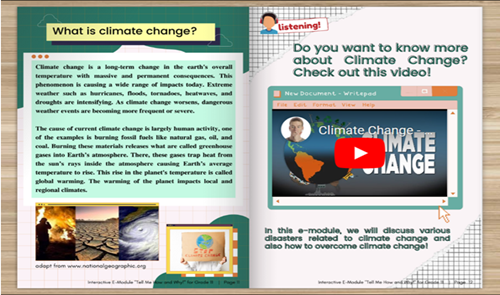
Developing An Interactive E-Module as Multimodal Learning Strategy in Fostering English Proficiency for High School Students
Abstract
Keywords
Full Text:
PDFReferences
Alizadeh, M. (2016). The impact of motivation on English language learning. International journal of research in English education, 1(1), 11-15.
Boone, H. N., & Boone, D. A. (2012). Analyzing Likert data. Journal of Extension.
Bremner, N. (2021). The multiple meanings of ‘student-centred’or ‘learner-centred’education, and the case for a more flexible approach to defining it. Comparative Education, 57(2), 159-186.
ButarButar, R., & Simatupang, E. (2020). The impact of technology hello English application in EFL classroom. Lingual: journal of language and culture, 8(2), 11.
Campoy-Cubillo, M. C., & Querol-Julián, M. (2021). Assessing multimodal listening comprehension through online informative videos: The operationalisation of a new listening framework for ESP in Higher Education. In Multimodality in English language learning (pp. 238-256). Routledge.
Canale, M., & Swain, M. (1980). Theoretical bases of communicative approaches to second language teaching and testing. Applied Linguistics. https://doi.org/10.1093/applin/I.1.1
Destianingsih, A., & Satria, A. (2017). A Study on Students’ Need Analysis on Web-based English Learning Materials. Inovish Journal, 2 (1), 48–57.
Fonda, A., & Sumargiyani, S. (2018). The Developing Math Electronic Module With Scientific Approach Using Kvisoft Flipbook Maker Pro For Xi Grade Of Senior High School Students. Infinity Journal. https://doi.org/10.22460/infinity.v7i2.p109-122
Groff, J. (2013). Technology-rich innovative learning environments. Oecd.Org.
Hafner, C. A., & Ho, W. Y. J. (2020). Assessing digital multimodal composing in second language writing: Towards a process-based model. Journal of Second Language Writing, 47, 100710.
Ifinedo, E., Rikala, J., & Hämäläinen, T. (2020). Factors affecting Nigerian teacher educators’ technology integration: Considering characteristics, knowledge constructs, ICT practices and beliefs. Computers & education, 146, 103760.
Islami, A. P., Novitri, N., Syarfi, M., Masyhur, M., & Afrianto, A. (2019, November). Increasing the Environment Feel in Learning through the Double S Application. In Journal of Physics: Conference Series (Vol. 1351, No. 1, p. 012111). IOP Publishing.
Jamil, N. A., & Aziz, A. A. (2021). The use of multimodal text in enhancing students’ reading habit. Malaysian Journal of Social Sciences and Humanities (MJSSH), 6(9), 487-492.
Khodadad, M., & Kaur, J. (2016). Causal relationships between integrative motivation, self-efficacy, strategy use and English language achievement. 3L: Southeast Asian Journal of English Language Studies, 22(3).
Klimova, B. F. (2011). Motivation for learning English at a university level. Procedia-social and behavioral sciences, 15, 2599-2603.
Linda, R., Herdini, H., S, I. S., & Putra, T. P. (2018). Interactive E-Module Development through Chemistry Magazine on Kvisoft Flipbook Maker Application for Chemistry Learning in Second Semester at Second Grade Senior High School. Journal of Science Learning. https://doi.org/10.17509/jsl.v2i1.12933
Mourlam, D. J., DeCino, D. A., Newland, L. A., & Strouse, G. A. (2020). “It's fun!” using students' voices to understand the impact of school digital technology integration on their well-being. Computers & Education, 159, 104003.
Qushem, U. B., Christopoulos, A., Oyelere, S. S., Ogata, H., & Laakso, M. J. (2021). Multimodal technologies in precision education: Providing new opportunities or adding more challenges?. Education sciences, 11(7), 338.
Reyes-Torres, A., & Raga, M. P. (2020). Multimodal approach to foster the multiliteracies pedagogy in the teaching of EFL through picturebooks. Atlantis, 42(1), 94-119.
Seftika, S., Mujiyanto, J., Faridi, A., & Sakhiyya, Z. (2021). The Use of Visual Design in Teaching Speaking: Multimodality in the EFL Classroom. In International Conference on Science, Education, and Technology (Vol. 7, pp. 901-905).
Sharma, K., Papamitsiou, Z., Olsen, J. K., & Giannakos, M. (2020). Predicting learners' effortful behaviour in adaptive assessment using multimodal data. In Proceedings of the tenth international conference on learning analytics & knowledge, 480-489.
Sugianto, D., Abdullah, A. G., Elvyanti, S., & Muladi, Y. (2017). Modul Virtual: Multimedia Flipbook Dasar Teknik Digital. Innovation of Vocational Technology Education. https://doi.org/10.17509/invotec.v9i2.4860
Sugiyono (2014). Metode Penelitian Pendidikan Pendekatan Kuantitatif Kualitatif Dan Pengembangan. Alfabeta, 2014.
Van Laar, E., Van Deursen, A. J., Van Dijk, J. A., & De Haan, J. (2020). Determinants of 21st-century skills and 21st-century digital skills for workers: A systematic literature review. Sage Open, 10(1), 2158244019900176.
DOI: http://dx.doi.org/10.31258/jes.6.1.p.200-214
Refbacks
- There are currently no refbacks.
Copyright (c) 2024 Annisa Permata Islami, Eliwarti Eliwarti, Muhammad Syarfi

This work is licensed under a Creative Commons Attribution 4.0 International License.
Publisher: FKIP Universitas Riau












